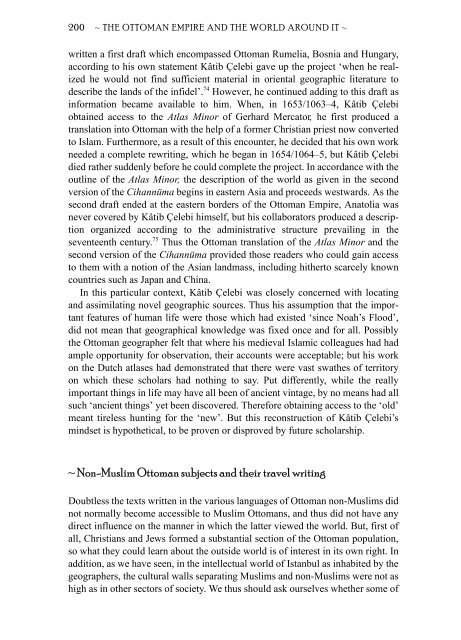The Ottoman Empire and the World Around It - Course Information
The Ottoman Empire and the World Around It - Course Information
The Ottoman Empire and the World Around It - Course Information
Create successful ePaper yourself
Turn your PDF publications into a flip-book with our unique Google optimized e-Paper software.
200 ~ THE OTTOMAN EMPIRE AND THE WORLD AROUND IT ~<br />
written a first draft which encompassed <strong>Ottoman</strong> Rumelia, Bosnia <strong>and</strong> Hungary,<br />
according to his own statement Kâtib Çelebi gave up <strong>the</strong> project ‘when he realized<br />
he would not find sufficient material in oriental geographic literature to<br />
describe <strong>the</strong> l<strong>and</strong>s of <strong>the</strong> infidel’. 74 However, he continued adding to this draft as<br />
information became available to him. When, in 1653/1063–4, Kâtib Çelebi<br />
obtained access to <strong>the</strong> Atlas Minor of Gerhard Mercator, he first produced a<br />
translation into <strong>Ottoman</strong> with <strong>the</strong> help of a former Christian priest now converted<br />
to Islam. Fur<strong>the</strong>rmore, as a result of this encounter, he decided that his own work<br />
needed a complete rewriting, which he began in 1654/1064–5, but Kâtib Çelebi<br />
died ra<strong>the</strong>r suddenly before he could complete <strong>the</strong> project. In accordance with <strong>the</strong><br />
outline of <strong>the</strong> Atlas Minor, <strong>the</strong> description of <strong>the</strong> world as given in <strong>the</strong> second<br />
version of <strong>the</strong> Cihannüma begins in eastern Asia <strong>and</strong> proceeds westwards. As <strong>the</strong><br />
second draft ended at <strong>the</strong> eastern borders of <strong>the</strong> <strong>Ottoman</strong> <strong>Empire</strong>, Anatolia was<br />
never covered by Kâtib Çelebi himself, but his collaborators produced a description<br />
organized according to <strong>the</strong> administrative structure prevailing in <strong>the</strong><br />
seventeenth century. 75 Thus <strong>the</strong> <strong>Ottoman</strong> translation of <strong>the</strong> Atlas Minor <strong>and</strong> <strong>the</strong><br />
second version of <strong>the</strong> Cihannüma provided those readers who could gain access<br />
to <strong>the</strong>m with a notion of <strong>the</strong> Asian l<strong>and</strong>mass, including hi<strong>the</strong>rto scarcely known<br />
countries such as Japan <strong>and</strong> China.<br />
In this particular context, Kâtib Çelebi was closely concerned with locating<br />
<strong>and</strong> assimilating novel geographic sources. Thus his assumption that <strong>the</strong> important<br />
features of human life were those which had existed ‘since Noah’s Flood’,<br />
did not mean that geographical knowledge was fixed once <strong>and</strong> for all. Possibly<br />
<strong>the</strong> <strong>Ottoman</strong> geographer felt that where his medieval Islamic colleagues had had<br />
ample opportunity for observation, <strong>the</strong>ir accounts were acceptable; but his work<br />
on <strong>the</strong> Dutch atlases had demonstrated that <strong>the</strong>re were vast swa<strong>the</strong>s of territory<br />
on which <strong>the</strong>se scholars had nothing to say. Put differently, while <strong>the</strong> really<br />
important things in life may have all been of ancient vintage, by no means had all<br />
such ‘ancient things’ yet been discovered. <strong>The</strong>refore obtaining access to <strong>the</strong> ‘old’<br />
meant tireless hunting for <strong>the</strong> ‘new’. But this reconstruction of Kâtib Çelebi’s<br />
mindset is hypo<strong>the</strong>tical, to be proven or disproved by future scholarship.<br />
~ Non-Muslim <strong>Ottoman</strong> subjects <strong>and</strong> <strong>the</strong>ir travel writing<br />
Doubtless <strong>the</strong> texts written in <strong>the</strong> various languages of <strong>Ottoman</strong> non-Muslims did<br />
not normally become accessible to Muslim <strong>Ottoman</strong>s, <strong>and</strong> thus did not have any<br />
direct influence on <strong>the</strong> manner in which <strong>the</strong> latter viewed <strong>the</strong> world. But, first of<br />
all, Christians <strong>and</strong> Jews formed a substantial section of <strong>the</strong> <strong>Ottoman</strong> population,<br />
so what <strong>the</strong>y could learn about <strong>the</strong> outside world is of interest in its own right. In<br />
addition, as we have seen, in <strong>the</strong> intellectual world of Istanbul as inhabited by <strong>the</strong><br />
geographers, <strong>the</strong> cultural walls separating Muslims <strong>and</strong> non-Muslims were not as<br />
high as in o<strong>the</strong>r sectors of society. We thus should ask ourselves whe<strong>the</strong>r some of


